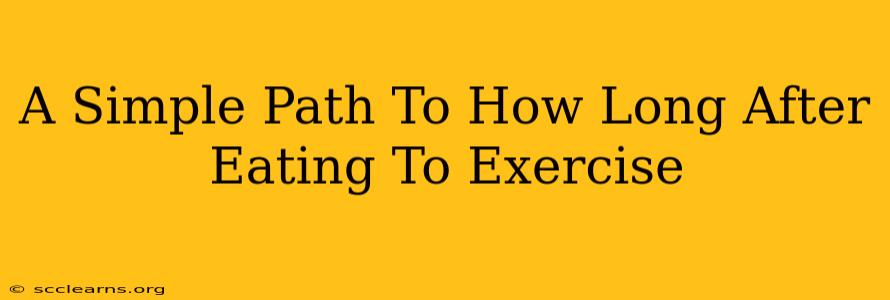Deciding when to exercise after eating is a common dilemma. Should you hit the gym immediately after a meal, or wait a while? The answer isn't a simple "one size fits all." It depends on several factors, including the intensity of your workout and the type of food you consumed. This guide will provide a clear path to understanding the optimal timing for your fitness routine.
Understanding Your Body's Digestive Process
Your body needs time to digest food. Immediately after a large meal, a significant portion of your blood flow is directed to your digestive system. This means less blood is available for your muscles during exercise. This can lead to discomfort, indigestion, and even reduced performance. Knowing how long after eating to exercise effectively boils down to understanding this process.
Factors Influencing Digestion Time:
- Type of Food: Fatty and high-protein meals take longer to digest than lighter meals with carbohydrates and fruits. A heavy steak dinner will require more time than a banana and some oatmeal.
- Meal Size: The larger the meal, the longer the digestion process. Smaller, more frequent meals are generally better for fueling exercise.
- Individual Metabolism: Metabolic rate varies from person to person. Some people digest food faster than others.
The Ideal Waiting Period: A Practical Guide
There's no magic number, but here's a helpful guideline based on the intensity and type of your workout:
Light to Moderate Exercise:
For activities like yoga, a light walk, or a leisurely bike ride, you can likely exercise within 30-60 minutes of eating a light meal. If it's a heavier meal, allow 1-2 hours. Listen to your body; if you feel discomfort, slow down or stop.
Moderate to High-Intensity Exercise:
For more intense workouts like running, weightlifting, or HIIT, it's best to wait 2-3 hours after a substantial meal. This allows sufficient time for digestion and ensures your body has enough blood flow to your muscles. A smaller, easily digestible snack might be okay 1-2 hours before a high-intensity session.
Pre-Workout Snacking:
If you exercise in the morning before a full breakfast or in the evening after a considerable gap between your last meal and your workout, consider a light pre-workout snack. Bananas, a small handful of nuts, or a piece of fruit can provide quick energy without weighing down your digestive system.
Recognizing the Signs of Digestive Discomfort During Exercise:
Pay attention to your body's signals. These are clear indicators that you might have exercised too soon after eating:
- Stomach Cramps: This is a primary sign of your body struggling to digest food while exercising.
- Nausea: Feeling nauseous during exercise is another key indicator to stop and rest.
- Bloating: Excessive bloating or gas can significantly impair performance and comfort.
- Reduced Performance: Feeling unusually sluggish or weak could indicate that your body is prioritizing digestion over muscle function.
Conclusion: Find Your Optimal Timing
Finding the optimal time to exercise after eating is a personal journey. Experiment with different timeframes based on the intensity of your workout and the types of food you consume. Listen to your body, and adjust accordingly. By understanding the relationship between digestion and exercise, you can optimize your fitness routine for peak performance and overall well-being. Remember that consistency is key! Establish a routine that works best for you, and stick with it.

